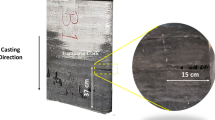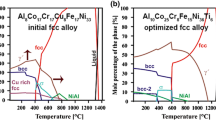Abstract
An attempt has been made to study the influence of the nature of microconstituents, strain rate and test temperature on the tensile properties of a zinc-based alloy (ZA 27). The properties of the alloy have been compared with those of a (leaded-tin) bronze (SAE 660) under similar test conditions. In the latter case, one of the phases (lead) has rather poor compatibility with the matrix. Properties such as hardness, density and electrical conductivity of the alloys have also been measured. The microstructure of the zinc-based alloy revealed primary α-dendrites surrounded by the eutectoid α+η in the interdendritic regions. The metastable ε phase was also present. The bronze revealed primary α-dendrites together with the Cu–Sn intermetallic in the interdendritic regions. Discrete particles of lead were also observed in the microstructure of the bronze. Increasing test temperature caused a reduction in the ultimate tensile strength (UTS) and an increase in the ductility of the alloys, the zinc-based alloy being much more influenced than the bronze. Higher strain rates revealed improved strength and percentage elongation in which the zinc-based alloy was once again influenced more than the bronze. A comparison of the tensile properties revealed the UTS of the zinc-based alloy to be higher than that of the bronze at lower test temperatures while the trend reversed at higher temperatures. However, the percentage elongation of the former was always higher. Tensile fractured surfaces revealed the occurrence of material failure by a mixed mode, i.e. ductile and brittle type. The bronze specimens exhibited microcracking along the lead/matrix interfacial regions at low test temperatures. Fracture of lead was also observed in this case. However, this tendency was somewhat suppressed at higher test temperatures. The contribution of ductile fracture in the case of the zinc-based alloy was more than the bronze in general, whose extent increased at higher test temperatures. Coarsening of the dimples was another observation made at elevated test temperatures in the case of the zinc-based alloy. The behaviour of the alloys has been explained in terms of their microstructural and fractographic features. An attempt has also been made to understand the mechanisms of material failure.
Similar content being viewed by others
References
D. Apelian, M. Paliwal and D. C. Herrschaft, J. Metals 33 (1981) 12.
D. Kaniki, Modern Castings March (1979) 49.
T. Calayag and D. Ferres, in “Proceedings of the Earth-moving Industry Conference, 19–21 April 1982, Peoria, IL.
W. Mihaichuk, Modern Castings July (1981) 39.
K. J. Altorfer, Met. Prog. November (1982) 29.
E. Gervais, R. J. Barnhurst and C. A. Loong, J. Metals 37 (1985) 43.
E. Gervais, H. Levert and M. Bess, Trans. AFS 68 (1980) 183.
P. P. Lee, T. Savaskan and E. Laufer, Wear 117 (1987) 79.
E. J. Kubel Jr, Adv. Mater. Proc. 132 (1987) 51.
L. D. Bailey, S. Dionne and S. H. Lo, in “Fundamental Relationships between Microstructure and Mechanical Properties of Metal Matrix Composites”, edited by P. K. Liaw and M. N. Gungor (The Minerals, Metals and Materials Society, 1990) pp. 23–5.
P. N. Dent and S. Murphy, in Proceedings of the International Symposium on Zinc–Aluminium (ZA) Casting Alloys”, 25th Annual Conference of Metallurgists, edited by G. P. Lewis, R. J. Barnhurst and C. A. Loong, CIM, (1986), pp. 127–42.
C. A. Loong, ibid., pp. 157–68.
E. Gervais, M. Lefebvre and C. A. Loong, in “Proceedings of the 13th SDCE International Diecasting Congress and Exposition”, paper no G –T 85-055 (1985) pp. 1–8.
C. A. Loong, in “Proceedings of the 14th SDCE International Diecasting Congress and Exposition”, Paper no G –T 87-027 (1987) pp. 1–7.
N. Mykura and S. Murphy, in Proceedings of the International Symposium on Zinc–Aluminium (ZA) Casting Alloys”, 25th Annual Conference of Metallurgists, edited by G. P. Lewis, R. J. Barnhurst and C. A. Loong (eds.), CIM, (1986) pp. 45–55.
H. Lehuy, J. Mater. Sci. 23 (1988) 2943.
M. Rtaplin, G. L. Dunlop and T. G. Langdon, Ann. Rev. Mater. Sci. 9 (1979) 151.
F. A. Mohammed, M. M. I. Ahmed and T. G. Langdon, Metall. Trans. 8A (1977) 933.
K. N. Melton and J. D. Edington, Met. Sci. J. 7 (1973) 172.
R. B. Nicholson, in “Electron Microscopy and Structure of Materials”, edited by G. Thomas (Berkely University, California Press, 1972) p. 689.
R. Guerriero, J. B. Parce and I. Tangerini, in “Proceedings of the International Symposium on Zinc–Aluminium (ZA) Casting Alloys”, 25th Annual Conference of Metallurgists, CIM, edited by R. J. Barnhurst and C. A. Loong (1986) pp. 229–248.
S. Murphy, Z. Metallkde 71 (1980) 96.
G. Walmag, M. Lamberights and D. Guetsouradis, in “Proceedings of the International Conference on Zinc–Aluminium (ZA) Casting Alloys”, 25th Annual Conference of Metallurgists, CIM, edited by G. P. Lewis, R. J. Barnhurst and C. A. Loong (1986) pp. 5–22.
S. Murphy and T. Savaskan, Wear 98 (1984) 151.
C. R. Brooks (ed.), “Heat Treatment, Structure and Properties of Non-Ferrous Alloys” (ASM, Metals Park, OH, 1982) pp. 275–82.
R. W. Heine and P. C. Rosenthel (eds), “Principles of Metal Casting” (McGraw-Hill, 1955) pp. 308–31.
W. A. Glaeser, in “Proceedings of the International Conference on Wear of Materials” edited by K. C. Ludema (ASME, Denver, 1989) pp. 255–60.
T. S. Srivatsan, S. Anand and T. S. Sudarshan, Mater. Sci. Technol. 10 (1994) 640.
C. Y. Lin, H. B. McShane and R. D. Rawlings, ibid. 10 (1994) 659.
T. Hikosaka, T. Imai, T. G. Nieh and J. Wadsworth, Scripta Metall. 31 (1994) 1181.
S. Mitra, J. Mater. Sci. Lett. 13 (1994) 1296.
G. L. Dunlop and D. M. R. Taplin, J. Mater. Sci. 7 (1972) 84.
S. Sagat and D. M. R. Taplin, Acta Metall. 24 (1976) 307.
F. Ashrafizadeh, J. M. Young and V. Kondic, Mater. Sci. Technol. 3 (1987) 665.
J. P. Pathak and S. N. Tiwari, Wear 155 (1992) 37.
B. S. Mazumdar, A. H. Yegneswaran and P. K. Rohatgi, Mater. Sci. Eng. 68 (1984) 85.
M. A. Savas and S. Altintas, J. Mater. Sci. 28 (1993) 1775.
Author information
Authors and Affiliations
Rights and permissions
About this article
Cite this article
PRASAD, B.K., YEGNESWARAN, A.H. & PATWARDHAN, A.K. Influence of the nature of microconstituents on the tensile properties of a zinc-based alloy and a leaded-tin bronze at different strain rates and temperatures. Journal of Materials Science 32, 1169–1175 (1997). https://doi.org/10.1023/A:1018523732492
Published:
Issue Date:
DOI: https://doi.org/10.1023/A:1018523732492




